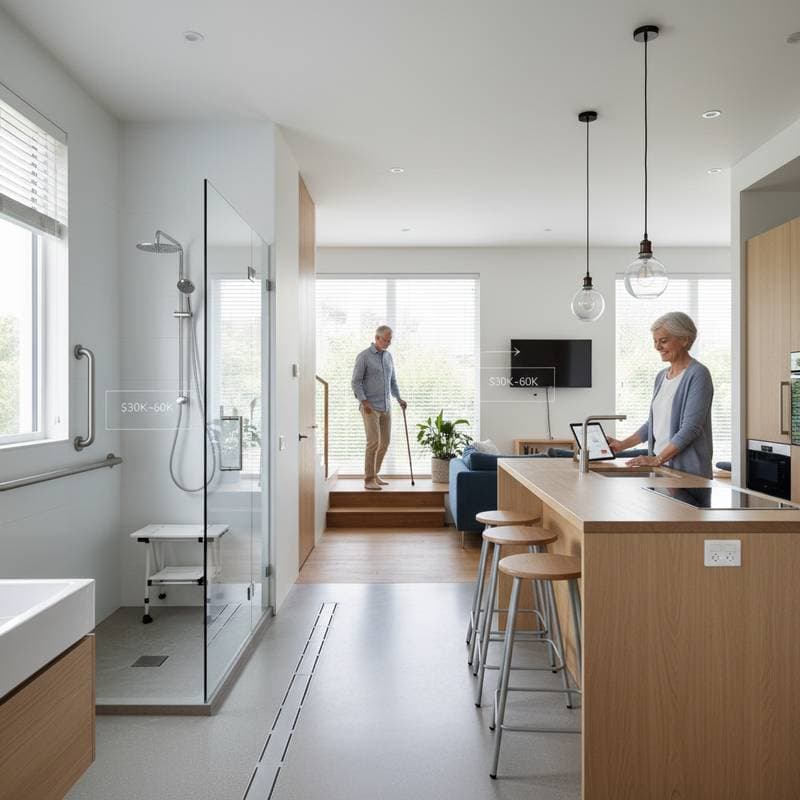Aging-in-Place Remodels: What to Expect in 2025
Aging in place allows individuals to remain in their homes as they age, rather than moving to assisted living facilities. This approach emphasizes modifications that enhance safety and accessibility while preserving comfort and independence. In 2025, remodels focus on integrating smart technology and sustainable materials to create adaptable living spaces.
Homeowners increasingly prioritize these updates to avoid the stress of relocation. Professional contractors report a rise in requests for features that support long-term residency. Understanding current trends helps in planning effective renovations.
Understanding Aging-in-Place Principles
Aging-in-place design follows universal principles that accommodate varying mobility levels. These include wide doorways, non-slip flooring, and lever-style handles for easier use. The goal remains to minimize physical barriers without sacrificing aesthetic appeal.
Experts recommend starting with a professional assessment of the home's layout. This evaluation identifies potential hazards like steep stairs or narrow hallways. Addressing these early prevents costly future adjustments.
In 2025, designs incorporate flexible elements, such as adjustable counter heights in kitchens. Such features allow customization as needs change over time. This proactive strategy ensures the home evolves alongside its occupants.
Key Trends Shaping 2025 Remodels
Smart home integration leads the trends for aging-in-place projects this year. Voice-activated systems control lighting, thermostats, and security without physical effort. These technologies reduce daily strains and enhance overall convenience.
Sustainability gains prominence, with remodels using eco-friendly materials like bamboo flooring and low-VOC paints. Solar-powered accessibility aids, such as automatic door openers, align with energy-efficient goals. Homeowners benefit from lower utility bills and a reduced environmental footprint.
Multifunctional spaces emerge as a practical solution for smaller homes. For instance, convertible furniture serves dual purposes, like a bed that transforms into a sofa. This approach maximizes usability while maintaining an open, inviting atmosphere.
Must-Have Accessibility Features
Bathroom Modifications
Bathrooms present the highest risk for falls, so updates focus on safety first. Installing grab bars near toilets and showers provides essential support. Walk-in showers with built-in benches eliminate tub-related hazards.
Heated floors and touchless faucets add comfort and hygiene. These elements prevent slips on cold surfaces and simplify operation for those with limited dexterity. Professional installation ensures compliance with building codes for durability.
Kitchen Enhancements
Kitchens require adjustments for seated or standing use. Pull-out shelves and lower cabinets facilitate access to essentials. Induction cooktops offer precise control with minimal bending.
Appliance garages hide small devices within reach, reducing clutter. Soft-close drawers prevent slamming, which can be challenging for arthritic hands. These changes promote efficient meal preparation without compromising style.
Entryway and Hallway Improvements
Ramping replaces stairs at main entrances for seamless wheelchair access. Motion-sensor lighting illuminates pathways automatically. Hallway widenings to at least 36 inches allow for safe navigation with walkers.
Threshold reducers smooth transitions between rooms. These subtle modifications maintain the home's original charm while improving flow. Contractors often suggest starting here for immediate impact.
Costs and Timelines for 2025 Projects
Budgeting begins with the scope of work. Basic updates, like installing grab bars and non-slip mats, range from $2,000 to $5,000. Full bathroom remodels average $15,000 to $25,000, depending on materials and labor.
Kitchen overhauls typically cost $20,000 to $40,000, incorporating custom cabinetry and appliances. Whole-home accessibility conversions can exceed $50,000 for extensive structural changes. Factors such as location and contractor rates influence these figures.
Timelines vary by project size. Simple installations complete in one to two weeks. Comprehensive remodels span three to six months, including planning and permitting. Early consultation with specialists streamlines the process and avoids delays.
DIY Options Versus Professional Services
DIY projects suit minor enhancements, such as adding adhesive grab bars or LED nightlights. These require basic tools and cost under $500. Homeowners gain satisfaction from personal involvement while saving on labor.
However, structural alterations demand professional expertise. Electricians handle smart system wiring to meet safety standards. Architects ensure designs comply with accessibility regulations like the ADA.
Hiring a certified aging-in-place specialist (CAPS) provides peace of mind. These professionals offer tailored plans and oversee execution. The investment yields a safer, more valuable home in the long term.
Planning Your Remodel: Next Steps
Assess your current home by walking through each room and noting challenges. Consult local resources for aging-in-place grants or tax credits. Gather quotes from multiple contractors to compare options.
Prioritize features based on immediate needs, such as mobility aids over aesthetic upgrades. Document your vision with sketches or photos for clear communication. This preparation sets the foundation for a successful project.
Benefits of Investing in Aging-in-Place Remodels
These modifications foster independence, allowing residents to age comfortably in familiar surroundings. Property values often increase due to enhanced accessibility and modern features. Families experience reduced caregiving burdens.
Health improves with fewer accidents and easier daily tasks. Emotional well-being benefits from staying connected to community and memories. In 2025, these remodels represent a wise choice for lifelong living.








